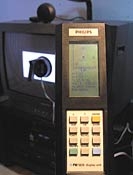TV Tweaks - Part One: House Calls Page 5
 |
| Right, the analyzer's display provides information on the color temperature, the light output, and the x and y coordinates on a standard color chart. |
The technician will make changes in the set's red, green, and blue levels until the gray rectangle in the windows matches the 6,500-K standard. Like a master chef, he'll add a pinch of this and a hint of that, going back and forth between the low and high windows until both measure the same.
While someone skilled with an optical comparator can do an acceptable job of grayscale adjustment, using a color analyzer provides more flexibility in adjustment and leaves no question about the accuracy of the result. The most common analyzers attach to the screen via a suction cup and provide readings of both color temperature in kelvins and light output in foot-lamberts, also plotting the precise points on the standard chart of color space. And unlike a comparator, an analyzer allows the calibrator to take readings at all points along the grayscale, not just the low and high windows. (For more about color temperature, grayscale, and how they relate to TV calibration, see "Behind the Numbers")
Once the grayscale adjustments have been made, the technician will double check the color, tint, brightness, and contrast settings and make any necessary changes. And that's it. All that's left is for the technician to give you a report on the pre- and post-calibration results for your set.
The most telling result is the colorimetry calibration, which is a graph of the color temperature in kelvins. Often, the "before" graph will resemble a roller-coaster year on the stock market, with temperatures ranging from 5,000 K to well over 10,000 K. The ideal post-calibration graph is a ruler-straight line holding 6,500 K at all points from 20 to 100 IRE. But most sets aren't able to track the grayscale that accurately throughout the entire range, so peaks and valleys of 200 to 300 K aren't uncommon - they won't be noticeable while you're watching DVDs or TV shows. Rear-projection TVs, for example, tend to exhibit a large dip (500 K or more) at the lowest end of the grayscale.
So how does it look? The most noticeable difference will be the set's overall light output - a properly calibrated set looks darker. That's because it's been adjusted for the best performance, within its capabilities, in a properly lit viewing environment. The image will look more natural, without artificially enhanced edges. Colors will look the way the content producer intended.
Even after watching for just a few moments, you'll be able to see the improvement by having the technician toggle between the calibrated setting and the Cool color-temperature preset. You won't believe the picture you'd been watching! More important, you'll know that your set is performing at its peak potential.
John Sciacca, the lead system designer for Custom Theater and Audio in Murrells Inlet, SC, recently completed an ISF certification course.
See Also: TV Tweaks Part 2 - Behind the Numbers
- Log in or register to post comments



































































